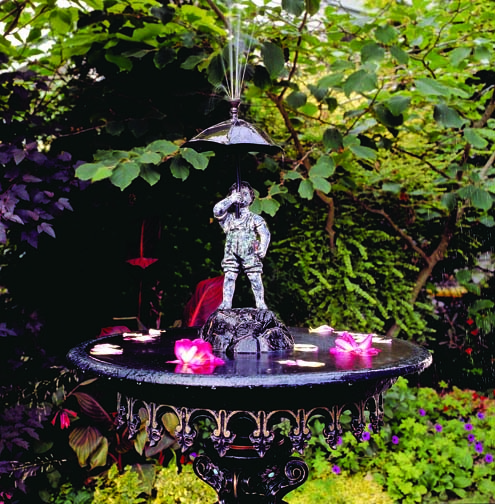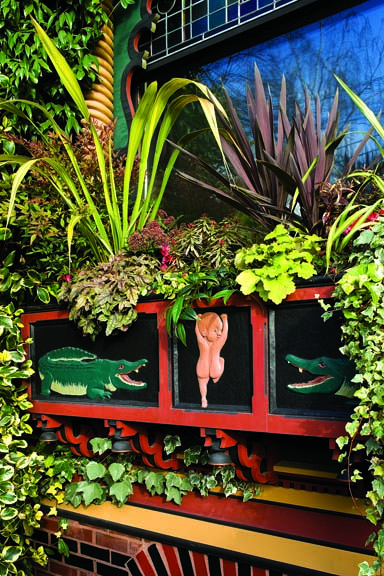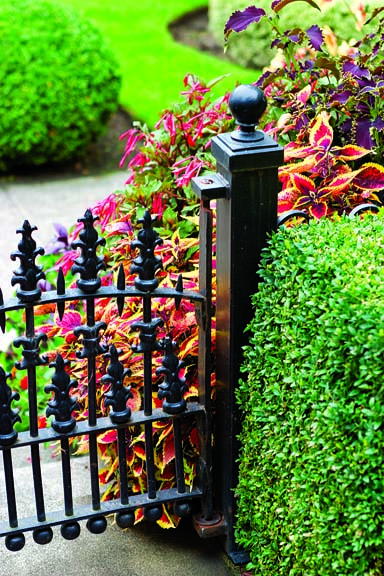The garden’s colorful palette was carefully chosen to complement the autumnal colors on the fanciful Queen Anne Victorian.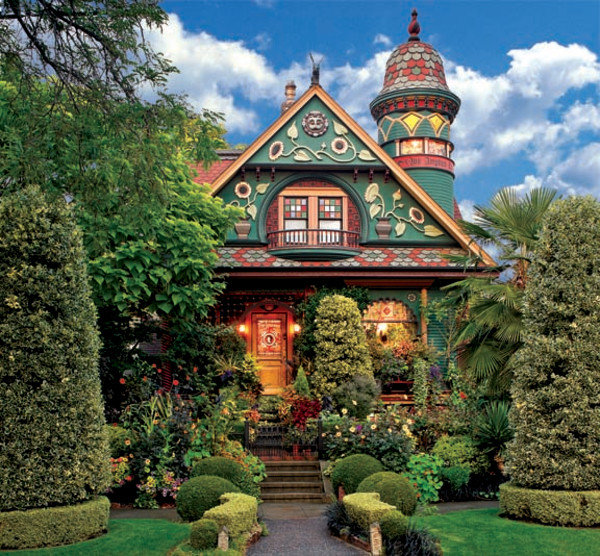
An enticing home, one that grabs your attention as you walk by, is often described as having “curb appeal.” The phrase can be applied to houses in pretty much any style or design, but all have this in common: They make people stop and stare.
Perhaps the home is a storybook cottage with swooping rooflines and a turret straight out of “Hansel and Gretel,” or maybe it’s a polychromed Victorian in a rainbow of tones. Sometimes it’s not the house at all, but the garden that causes cars to slow down and drivers to lean out their windows and point. With my house in Seattle, it’s been a bit of all three: The turreted house, in a colorful paint scheme, is nicely complemented by landscaping that was carefully coordinated to match my home’s bold hues, resulting in a cohesive—and attractive—whole. But it wasn’t always this way.
When I bought the house two decades ago, it was covered in white vinyl siding, the yard was full of dead grass, and planting beds were littered with broken bottles. Over the years, I’ve transformed the early 1900s Craftsman into my dream house, a high-style Queen Anne Victorian, adding a turret, sunflower and griffin carvings on the upper gables, and roof cresting created from a late-1800s cemetery fence. After I painted the house in a late-19th-century fall palette of deep green, burgundy, black, copper, and gold—a combination derived from period sourcebooks of popular Victorian house paint colors—I guess I shouldn’t have been surprised when I came home one afternoon to find a wedding party posing on my front steps. Creating a garden to complement my fanciful grande dame was a major undertaking.
Pots of richly hued coleus and geraniums line the front steps, accenting both stained glass and paint colors, while a passion vine clambers over the Saracenic arch.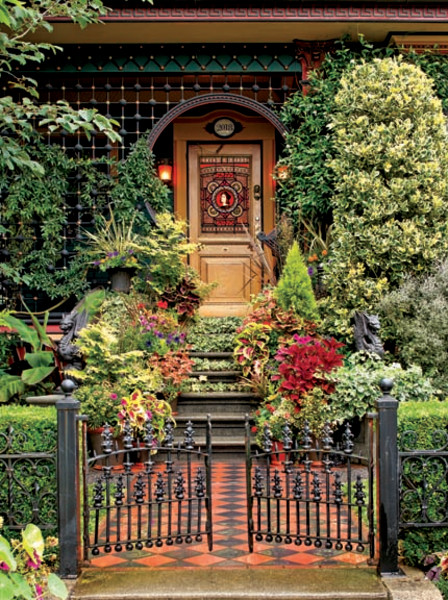
Mapping Changes
The sole survivor of the previous owner’s landscaping efforts was a surprisingly virulent holly plant, which covered the front yard in perpetual shade. It needed to go, so with the help of landscape designers Charles Price and Glenn Withey, I attacked the yard, devising a garden to coordinate with the new colors of the house. While color was our primary consideration, we researched and used as many Victorian plants as we could.
Because the front yard is shallow, only 22′ deep, and easily overwhelmed by the two-story house, we planted variegated English holly trees (Ilex aquifolium) in the parking strip to anchor the garden and visually pull it down and out toward the curb. They have since been pruned, based on classic English topiary gardens, into conical accents marking the garden’s entrance.
Seattle was built on a series of hills, with many of its early 20th-century homes designed with sloping front yards meant for planting. Although these beds were often later replaced with low-maintenance rock gardens and walls, I chose to keep my garden beds intact for color and visual interest. My landscape designers and I evolved an admittedly high-maintenance scheme of seasonal plantings whose colors would coordinate with the autumn palette of the house.
While the fall and spring are attractive with winter pansies and a few bulbs, the yard really comes into its prime in the summer, when it blooms in vibrant swathes of color from hybrid, sun-tolerant cultivars of coleus in a rainbow of burgundy, chartreuse, copper, and gold; dark-leafed dahlias (Dahlia ‘Moonfire’), with their bronze leaves and pale ochre and orange flowers; and fancy-leafed pelargoniums such as ‘Vancouver Centennial,’ with its intense, two-toned foliage of deep terracotta and chartreuse. Victorian favorites include lime green and yellow variegated Plectranthus; Fuchsia ‘Gartenmeister Bonstedt,’ with reddish bronze foliage and intense, deep red single flowers that show all summer; and the purple-foliaged castor bean (Ricinus communis ‘Carmencita’). One of my favorites is the Persian Shield plant (Strobilanthes dyeriana), with its metallic-looking silver and purple leaves. I used architectural salvage to help tie the garden together and provide a foundation of instant age for the plantings, running antique iron fencing that I found at a flea market along the top of the slopes, and backing it with a neatly clipped dwarf boxwood hedge (Buxus sempervirens ‘Suffruticosa’) for year-round structure.
I had “Long Tom” Victorian pots—long, narrow, thinly lipped pots ideal for seedlings—custom made in combinations of black and red to coordinate with the colors of the house, and placed them on the front steps. We filled them with fragrant lavender heliotrope (Heliotropium arborescens); fancy-leaved pelargoniums like ‘Mrs. Pollock,’ ‘Skies of Italy,’ and ‘Mrs. Henry Cox’; and modern, colorful coleus cultivars like ‘Carrot Top,’ ‘Sedona,’ and ‘Inky Fingers.’
To add even more visual interest, I commissioned a hand-carved window box with alligators eyeing an anxious baby—the design inspired by fanciful carvings I saw on Cardiff Castle in Wales—for the front window, and planted it with multicolored Canna, orange- flowered abutilon, and the tender, trailing Fuchsia ‘Autumnale’ (its kaleidoscopic, deep pink and terracotta foliage turns yellow, then pale green through the season). I installed more Victorian salvage to help anchor the flowers and add to the ambience, placing vintage iron griffins at the bottom of the porch steps, and a cast iron Fiske fountain, set as a focal point, in the upper front yard.
Yard Work
In the narrow side yard on the north, which never sees direct sun, we planted low-maintenance Hosta ‘Halcyon’ and ‘Regal Splendor,’ which are both relatively bug-proof. Different evergreen and herbaceous ferns, mostly forms of Dryopteris, along with another of my favorites, the ‘Tatting Fern’ (Athyrium felix-femina ‘Frizelliae’), were used to fill in the narrow planting beds along the house, along with variegated Persian ivy (Hedera colchica ‘Dentata Variegata’) in creamy white and slate green.
The tiny back yard is a private retreat enclosed by a lattice fence, plated with shade-tolerant ferns, hydrangeas, and perennials, and accented with vintage architectural finds.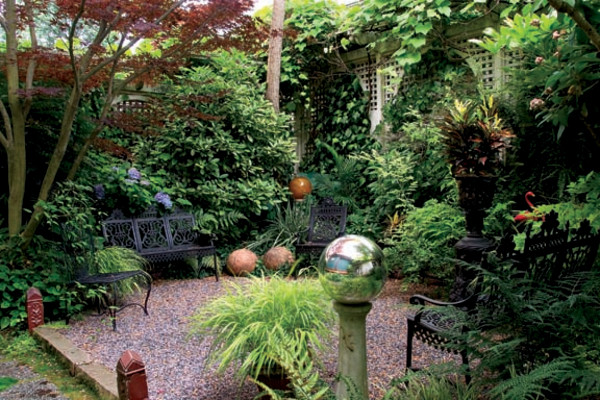
To enclose the tiny back yard, I built an arched lattice fence topped with an arbor and planted table grapes (Vitis ‘Interlaken’ and ‘Niagara’) to clamber over it. Another variegated Persian ivy (Hedera colchica ‘Sulphur Heart’) was trained up the lattice arches. Two 12′-tall locust trees (Robinia pseudoacacia ‘Frisia’), along with a red-leafed Japanese maple (Acer palmatum), screen the backyard from neighboring houses that look down directly into the space. After several years of effort, I gave up trying to keep a lawn alive in the constant shade and replaced it with a more practical ellipse of colored gravel, which I surrounded with antique clay edging tiles. I found more Victorian garden ornament: a pair of large terracotta balls; a set of wrought iron benches with a matching chair; and a massive, late-19th-century iron planter of a stag’s head supporting an open-weave basket—a typically curious Victorian creation.
Looking for more garden inspiration? See our pictures of the best hydrangeas for historic gardens.
Like all gardens, the work is never done—with help from gardener Riz Reyes the hollies and box are patiently pruned twice a year, seasonal plantings revised and updated as local nurseries change their stock, and perennials replaced as they become leggy or overgrown. But I don’t mind: With strong color, architectural salvage, and a sense of whimsy, my garden remains what I hoped it to be—a creative and enjoyable extension of my Victorian home.
Brian Colemanis a practicing psychiatrist in Seattle, Washington, who has turned his love of old houses into a second career as the author of 14 books and numerous articles on the decorative arts.
Online exclusive: Get the inside scoop on how Brian selected the Victorian exterior paint colors for his house.



